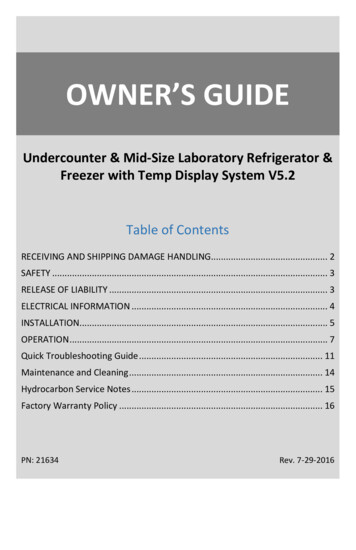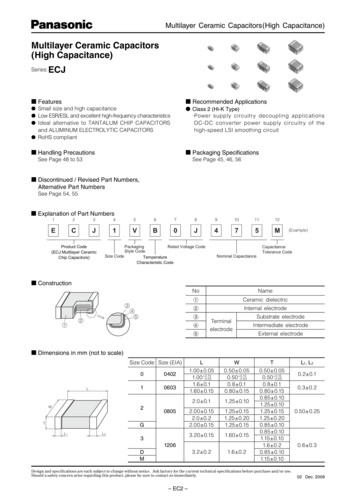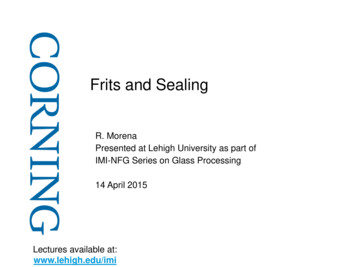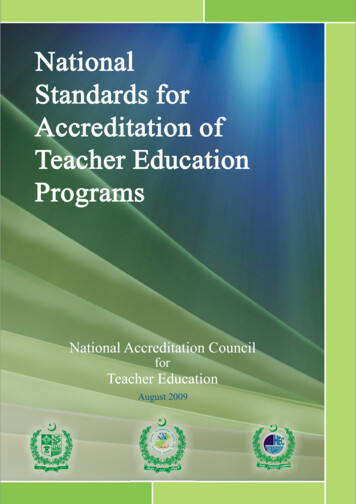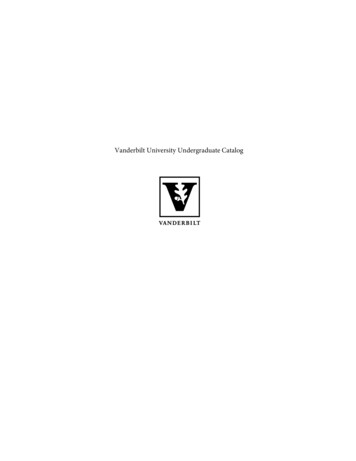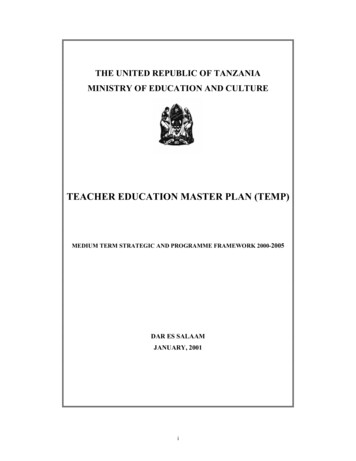
Transcription
THE UNITED REPUBLIC OF TANZANIAMINISTRY OF EDUCATION AND CULTURETEACHER EDUCATION MASTER PLAN (TEMP)MEDIUM TERM STRATEGIC AND PROGRAMME FRAMEWORK 2000-2005DAR ES SALAAMJANUARY, 2001i
PREFACEThe Tanzania vision 2025 sees education as a strategic agent for mindsettransformation and for the creation of a well educated nation that can face thedevelopment challenges facing the nation. This requires multi-sectoral strategies andactions which are integral to overall development efforts. In this regard thegovernment has embarked on sector development approach and the Ministry ofEducation and Culture is taking forward Education Sector Development Programme(Ed-SDP) which intends to improve the education system.For elaboration of the programme, the government has taken several initiatives. Thisincludes development of Basic Education Master Plan (1997) and SecondaryEducation Master Plan (1998). The Teacher Education Master Plan (TEMP) is yetanother effort to translate our education and training policies into actions.The Teacher Education Master Plan is an integrated framework of training and retraining for educators in formal and non-formal education context. It covers otherissues such as management and administrative structures, financing mechanisms,curriculum monitoring, and evaluation methods. The TEMP has been developedtaking into consideration existing practices and structures. It is also build on existingteacher education programmes.The purpose of the TEMP is to strengthen the machinery for policy formulation,professional development, monitoring and evaluation of teacher training and learning.However, the Education and Training Policy will continue to guide teacher educationdevelopment in the country.I hope that TEMP will not be an end product but will provide a basis for furtherdevelopment of the teacher education programmes on regular basis. I also hope thatthe completion of TEMP will give way for the development of an IntegratedEducation Development Master Plan covering all the education sub-sectors.MRS M. MALALEPERMANENT SECRETARYii
LIST OF O ETWGTOTsTPTPRTTUTRCTSCUDSMVETAVTTCAdvanced Certificate of Secondary EducationBachelor of ScienceBlock Teaching PracticeComplementary Basic Education in TanzaniaCertificate of Secondary EducationDistrict Based Support to Primary EducationEducation Sector Development ProgrammeEducation Management Information System.Education and Training PolicyFaculty of EducationIntegrated Community Based Adult EducationInformation Communication TechnologyIn-service Education and TrainingLocal Government Reform ProgrammeMinistry of Labour and Youth DevelopmentMinistry of Education and CultureMinistry of Science Technology and Higher EducationNational Examinations Council of TanzaniaNon-Governmental OrganisationOpen University of TanzaniaPre-service Education and TrainingRoyal Netherlands EmbassyPre-service Education and TrainingRegular Preventive MaintenanceScience Education in Secondary SchoolsSwedish International Development AgencySingle Lesson Teaching PracticeStudent Per Capita ExpenditureScience Teachers In-service ProgrammeStudent Teacher RatioTeachers CollegesTeacher Education DepartmentTeacher Education Management Information SystemTeacher Education Master PlanTeacher Education Technical Working GroupTraining of TrainersTeaching PracticeTeacher Pupil RatioTanzania Teachers UnionTeachers Resource CentreTeachers Service CommissionUniversity of Dar es SalaamVocational Education and Training Authority.Vocational Teachers’ Training Collegeiii
TABLE OF CONTENTSCONTENTSPREFACELIST OF ABREVIATIONSTABLE OF NAL ANALYSIS2.1Quality of Teacher Education and Training2.2Access and Equity2.3Management and Administration2.4Financing1445563.0.ISSUES AND PROBLEMS ADDRESSED BYTHETEACHER EDUCATION MASTER PLAN3.1Quality3.2Access and Equity3.3Management and Organisation3.4Financing8891012VISION AND MISSION OF TEACHER EDUCATIONAND OBJECTIVES OF TEMP4.1Vision4.2Mission4.3Objectives of TEMP131313145.0SUMMARY OF PROGRAMMES156.0PRIORITY PROGRAMMES AND COMPONENTS6.1QUALITY PROGRAMMES6.2ACCESS AND EQUITY PROGRAMMES6.3MANAGEMENT AND ORGANIZATIONPROGRAMMES6.4FINANCING PROGRAMMES1818384.04252ATTACHMENTSAttachment 1. TEACHER EDUCATION MASTER PLAN58(TEMP) IMPLEMENTATION FRAME WORKAttachment 2: LIST OF KEY DOCUMENTS REVIEWED75Attachment 3: SECONDARY EDUCATION TEACHERS DEMAND76AND SUPPLY 2000-2005Attachment 4 PROJECTION OF TEACHERS AND ADULTEDUCATION FACILITATORSAttachment 5 PRIMARY SCHOOL ENROLMENT PROJECTIONS79Attachment 6 TEACHER EDUCATION PROJECTIONS81iv80
TEACHER EDUCATION MASTER PLAN1.0 INTRODUCTIONThe Teacher Education Department (TED) is the foundation of other departments inthe Education Sector. This is because of its crucial role of producing professionalsand leaders for the entire education system.It is responsible for first, developing and monitoring of teacher education, including: reviewing the teacher education curriculum, the teaching materials andteaching methods; setting and monitoring standards of training; overseeing professional development of teachers and tutors, ensuring accessand equity for all in the profession; and monitoring programmes and projects.Second, it is responsible for overall management of the teacher education sub-sector,including: reviewing policy, plans and regulations; processing applications for ownership and registration of teachers colleges; issuing guidelines for selection of students to teachers colleges; co-ordinating tutor recruitment, and deployment; processing application of teaching licences in Teachers’ colleges (TCs) issuing guidelines on management and administration of TCs; and co-ordinating budget preparation and financial resource allocation to teacherscolleges.Teacher Education is currently managed by at least three ministries. The Ministryof Education and Culture (MOEC) manages a network of 34 government TeachersColleges and provide guidance to 10 privately owned ones. The Ministry ofScience, Technology and Higher Education (MSTHE) manages university basedteacher education offered by the Faculty of Education (FOED) at the University ofDar es Salaam (UDSM), the Open University of Tanzania, the Sokoine Universityof Agriculture, Tumaini and St Augustine Universities in Tanzania.TheMinistry of Labour and Youth Development manages a Vocational TeacherEducation Programme, currently offered at the Morogoro Vocational Teachers’College.The 34 government TCs have a capacity of 14,500 student teachers at certificateand diploma level. Certificate teachers are deployed in pre-primary and primaryschoolswhereas diploma teachers are deployed at secondary schools and TCs. The TCsoffer both pre-service teacher education (PRESET) and in-service teachereducation (INSET). PRESET programmes include Grade A Teaching Certificatecourses and Diploma in Education courses. The two programmes last for twoyears and are mainly residential. Private colleges have a current enrolmentcapacity of 2000 students. However, actual enrolment has never exceeded 350students.1
The curriculum of the two year programmes includes academic and professionalcomponents. The academic component focuses on improving content knowledgein the teaching subjects. The professional component focuses on provision offoundation knowledge in the principles of education, child psychology, researchand educational management. The pedagogy component focuses on methods ofteaching and micro-teaching. There is also field experience called BlockTeaching Practice (BTP)) which lasts for 6-8 weeks annually during whichstudents do practice teaching in the schools.The INSET programmes consist of short courses of 3-9 months duration. There isalso an upgrading programme intended to upgrade Grade C/B teachers to firstordinary level secondary school education and then to Grade A teachersprofessional training. The professional up-grading course takes one year.At university level the system offers the following programmes: Bachelor of Education programmes in Science or Arts. These are programmefor students training to work mainly as tutors in teacher education institutions. Bachelor of Arts with Education, Bachelor of Science. with Education(UDSM) and Bachelor of Commerce with Education offered by mainly OUT.Students under these programmes train as teachers of various subjects to workin secondary schools and sometimes in Teachers’ Colleges, Bachelor of Education programme for adult education students. These worklater in Adult Education centres as tutors or in districts as adult educationadministrators. The Sokoine University of Agriculture also produces a few students with aBSc. in agricultural education and extension services who are prepared asextension workers for farmers in agriculture as well as teaching in agriculturebiased secondary schools and colleges.The Education and Training Policy (ETP) emphasises, among other things, theneed to promote the following skills in trainee teachers: competence and effectivecommunication in English and Kiswahili, competence in the teaching of scienceand technology, as well as effective teaching. ETP also mandates that primaryschool minimum teaching qualifications should be Grade A and for secondaryschools, a good combination of diploma and degree teachers while in TCs itshould be mainly university degree teachers.Access to teacher education is competitive. TCs are spread throughout thecountry.Most TCs are co-educational (with the exception of 4 which areexclusively for females and one for males). In 1998 TCs employed a total of 1004tutors (227 graduates, 621 with diploma, 10 with Grade A and 127 with SpecialCertificates).The management and administration of TCs is centralised under the Director ofTeacher Education in MOEC. Each TC has a Principal and a Deputy Principal.MOEC recruits, and promotes college tutors, admits students, appoints andtransfers college principals and tutors. Curriculum development and review forTCs is a professional task of the Tanzania Institute of Education.2
The university faculties of education are more autonomous with deans and headsappointed in the university authorities as stipulated by their acts of parliament.The university curricula are designed, reviewed and revised by the faculties andeventually approved by the University Senate.Financing of teacher education is done centrally from MOEC, MSTHE, or MLYDthrough budget allocation from the treasury. INSET programmes are usuallyunderfunded. This makes INSET courses irregular, and poorly co-ordinated. Costsharing in PRESET and long INSET courses by student teachers began in 1996.A college fee of Tsh. 85,000/ is currently charged to each student annually3
2.0SITUATIONAL ANALYSISDespite visible success in the training of teachers many problems also exist.There is therefore great need to reform the teacher education sub-sector in orderto improve access and equity in the teaching profession, improve the quality ofprogrammes and the curriculum in general, improve management and financingarrangements while maximizing the use of available resources.2.1Quality of Teacher Education and TrainingThe PRESET programmes are meant to supply well trained teachers for theentire education system. Thus, there is need to regularly -review them toascertain their quality, relevance and appropriateness. There is also need toreview the demand for teachers in various disciplines, including the recentlycreated subjects called Work Skills (Stadi za Kazi). The issue of specialisationof teachers into subject clusters rather than trying to produce all round experts,is yet another issue worth considering. Similarly there is need to improve themanagement and financing of the practice teaching component, and institutinga culture of regular review and revision of the teacher education curriculum.The condition of some TCs is considered adequate due to recent maintenanceprogrammes. However, the majority of the colleges are in poor shape withdeteriorating buildings, furniture, books, sewage, and other infrastructure. Theteaching and learning environment is also poor, with unequipped sciencelaboratories, poorly stocked libraries and lack of other learning resources.Both areas in the teacher education (PRESET and INSET) that requireimprovement can best be done by carrying out a qualitative needs assessmentin order to identify pedagogical deficiencies of teacher training and theshortcomings of curriculum content knowledge, pedagogy and practical skillsamong teachers. This process will help confirm (or refute claims) made bysome schools and the general public that: current training programmes do not produce the skills needed for teachingin schools and colleges;programmes turn out excess arts and humanities teachers and insufficientscience, maths and language teachers;Grade A PRESET programme is too ambitious, trying to train teacherswho can teach all subjects in the curriculum rather than encouragingspecialization and excellence;teacher education curriculum is not systematically developed and does notgather the views of key stakeholders and clients of the programme;programmes are inflexible and do not cater for different beneficiaries withdiverse needs and interests;curriculum is too theoretical and conservative and does not encourageinquiry, critical thinking and reflective practice.4
2.2Access and EquityAccess to teacher education is competitive and open to all secondary schoolleavers depending on the level they want to train, and provided they qualify tojoin the teaching profession. Currently (2000) 44 public and private 10 TCswith an enrolment capacity of above 16,500, train Grade A teachers for 11,516primary schools, enrolling 4,057,965 pupils. The training of teachers alsoinclude diploma teachers for 890 secondary schools with an enrolment of225,607 pupils. The universities train about 500 graduate teachers annuallyfor secondary schools and TCs.Teacher Pupil Ratio for (TPR) primary and secondary schools is 1:37 and1:20 respectively while the Teacher Student Ratio (TSR) for teachers collegesis currently 1:10. These ratios are often considered to indicate underutilizationwhen compared to recommended policy figures (1:45 primary, 1:28 secondaryand 1:17 for TCs). It is debatable, however, as to whether the recommendedratios are ideal for conducive learning or they are merely set to meet economicconstraints.In INSET programmes there is also a more serious imbalance in access totraining among married women teachers, and teachers in remote areas who areunable to attend regular courses for a number of reasons. There is genderimbalance in PRESET and INSET enrolment in some key courses such asscience and mathematics. A flexible national plan for INSET provision alsoneeds to be worked out.The opening of Teacher Resource Centres (TRCs) is expected to solve theproblem of women and teachers from remote areas but this can only happen ifthe TRCs are evenly distributed, properly co-ordinated, and their programmeswell designed and managed. There is a need to build more TRCs and equipthem and also train the trainers who will manage the training programmesoffered there.The issue of capacity building for TCs, TRCs and Ward Based TeacherSupport will be addressed by opening up opportunities for graduate andpostgraduate teacher training in higher education institutions in order to meetgrowing demand of master or mentor teachers, trainers, INSET facilitators andmanagers .2.3Management and administrationCurrently TCs are managed by principals who are answerable to MOEC’sDirector of Teacher Education. Universities are more autonomous. TeacherResource Centres have yet to establish a clear management structure. The linkbetween TCs and TRCs is weak and needs strengthening. Management andadministration of TCs do not allow for high level power sharing betweencollege boards and MOEC. The prevailing feature of management andadministration is one of high concentration at MOEC in relation to recruitment5
and selection of teacher trainees to the PRESET and INSET programmes,promotion and appointment to position of leadership. Lack of TeacherEducation Management Information System (TEMIS) makes it difficult tomake decisions due to lack of sufficient data.College boards arebureaucratically selected and there is a tendency of selecting incompetentmembers whose roles are limited to advisory capacity. This makes boardsinefficient and taking long time to make decisions and settle disputes. Someadministrators in MOEC and its institutions are inadequately trained inmanagement.There is lack of motivation to excel due to low incentives to outstandingperformance in teacher education including acquisition of higher academic orprofessional qualifications. The procedures for assessment of teachereducators, and their living and working conditions, are often inappropriate.The criteria for changing teachers grades and the notification to teachers onmatters that concern their welfare, is also inadequate.Other poorly managed areas include boarding and catering services, physicaleducation, sports and games facilities, social, medical and security services.There are also very poor communication (including telephone and ICT) andtransport services, thus making management of teachers colleges, especially inremote rural areas, very difficult.There is a need to establish and reinforce proper administrative structures andprocedures in TCs. This involves defining the number of streams of entry,fixing levels of intake, and standardising length of the teaching period,determining the weekly working load of tutors and setting clear criteria fordetermining the entitlements for the staff. This is needed in order to improveefficiency and effectiveness of operation. There is also a need to rationaliseTCs and allow for specialization into primary or secondary curricula.A credit system to record and reward INSET attendance and professionalcompetence is lacking. Despite the existence of school inspectorate,monitoring and enforcement of set standards of teacher education is poor. Theweak co-ordination and monitoring of private TCs from MOEC have made itpossible for their stakeholders to violate current regulations and guidelines foropening private TCs. This needs to be addressed by tightening the mechanismof accreditation and control of TCs and other educational institutions.2.4FinancingThe financing of teacher education is basically centralized. However, the subsector remains among the lowest financed. The bulk of the central fundingmainly finance teacher salaries and related payments, leaving a smallproportion for other development activities. For example,. developmentfunding has often fluctuated, falling from 2.5% (1995) to 1.8% (1996) andrising again to 2.5% in 1998. The low level of funding for Teacher Educationhas often led to deterioration of college facilities, shortage of teaching andlearning materials, shortened college terms and abandoned BTP. This has also6
led to grater dependence on student fees to meet running costs, consequentlyresulting in low enrolment, retention and quality of education provided.Teacher education development expenditures have been in the area of INSETtraining programmes. Most of the development projects suffer from seriousunder funding and poor reporting and co-ordination. The monthly fundingsystem (cash budget) does not allow for flexibility in planning at institutionallevel. Auditing and other financial supervision are irregular and institutionalmanagers are inadequately trained in modern financial management andadministration skills.The need for financing are greatest in the PRESET and INSET programmedevelopment and management. Increased funding here will update teachertrainers with latest content and pedagogical skills. Improved funding for TCswill also improve the learning environment, thus leading to production of welltrained and effective teachers.A well trained and resourced pool of teacher educators means that they canproduce competent teachers for the school, and also retrain the ones already inthe schools. Adequate investment in teacher education, can therefore improvethe profession much faster. Trainers can be produced locally in earmarkedTCs or at the local Universities, through tailored postgraduate, Masters, orother in-service programmes. Where necessary, training of key trainers(tutors) can be done abroad. Maintenance of links with other internationalinstitutions and training centres will help maintain international quality intraining.The current zero financing of Teacher Resource Centres, by government needsto be redressed by allocating funding for staffing and management of thecentres. The search for foreign financing for these centres will continue asthey have great impact on professional development at local level. The coordination of donor support in this area is crucial in order to ensure that TRCsare spread evenly throughout the country and they are of comparable quality.The high cost of residential PRESET and INSET courses may be lowered bychannelling some trainees through TRCs and offering flexible teachereducation programmes and allowing for non-residential training.These issues are summarised in the next section, and in the main section of thedocument which follows. Programmes are developed to address the problemsand issues raised.7
3.0ISSUES AND PROBLEMS ADDRESSED BY THE TEACHEREDUCATION MASTER PLANThe following issues and problems are those requiring action by the MasterPlan. The issues and problems are:3.1Quality: Despite recent review of various curricula at various levels, there are noorientation courses/programmes of college tutors and teachers to newcurricula and effective teaching strategies at primary, secondary and otherlevels. The PRESET curriculum does not address some of the subjects taught inprimary school e.g. Stadi za Kazi, and Maarifa ya Jamii. Current upgrading INSET programme does not give opportunity for teachersto grow professionally within the pre-primary and primary system; it tends toencourage exit from the system and join secondary or other sectors. Teacher education curricula at Grade A and Diploma level are not adequatelysynchronised. Currently teacher education curricula focus more on imparting academiccontent than developing professional knowledge, skills, and attitudes. There are inadequate library facilities in most of the Teachers Colleges. Some of the tutors in Teachers Colleges are underqualified, unqualified anduntrained. There is no subject specialisation for grade A student teachers inTeachers Colleges. This forces a teacher to be a jack of all trades. Some PRESET and INSET programmes are not based on adequate needsassessment and appropriate curricula. Despite the existence of a number of educational projects and programmes,knowledge, skills and dispositions gained from these educational projects arenot adequately utilised and mainstreamed in the pre-service and in-serviceteacher education programmes. A number of TRCs have been established recently by various agents.However, there is no comprehensive programme for training TRC personnelor training teachers at TRCs. The infrastructure and teaching and learning environment of some TCs are invery poor state.8
Gender sensitivity training is a weak component in the curriculum. Currently there are weak linkage between teacher education programmes andhigher education programmes. The preparation of teachers to handle the issues of STDs and HIV/AIDS,environmental science and technology education is inadequate. There is lack of communication skills improvement programme in bothEnglish and Kiswahili for student teachers in Teachers Colleges. This stiflesthe communication ability of teachers and tutors and affects their effectivenessin teaching. As a result there has been a decline of communication standardsin Tanzania education in general and many people think it is only a problem ofmedium of instruction. There is no regular review of Teacher Education Curriculum. Existingcurriculum is out of date and does not balance academic and professionaltraining adequately. Little field experience exists to translate foundational andpsychological knowledge into classroom practice. There is shortage of teachers and limited capacity to train teachers in WorkSkills, Music, Fine Art, Theatre Arts, Physical Education, Special NeedsEducation, Agricultural Science, Technical Education and Home Economics.Training programmes for these teachers are few and their curriculum is fairlylimited to cater for the needs of a diversity of children in the schools. Assessment of student teachers appears to focus too much on pencil and papertests and less on practical tasks. There is a mismatch between classroomperformance of teachers and teachers examination results, such that thosescoring very high marks in examinations are not necessarily effective in theclassroom. There is no holistic approach in upgrading programmes. Teachers areupgraded on an ad-hoc basis, which does not help maintain standards ofteacher qualifications in the system. 3.2The quality of teaching and learning Science and Mathematics is poor inschools and teachers colleges. This is due to many factors but teacher quality,gender stereotyping and instructional materials rank top among them.Access and Equity Although the problem of professional development is a general one, there is amore serious inaccessibility of INSET opportunities among certain groups ofteachers, including women, teachers of certain subjects such as Arts andCrafts, and teachers in remote areas. These groups tend to be stagnant andfrustrated.9
Many TRCs have been opened during the last five years. However, there isuneven distribution of TRCs nationally, since they are not properly coordinated. This makes some areas have very few while others haveabundance. There is gender imbalance for both trainees and tutors in TCs. Women participation especially in Science, is still low. There is studentwastage due to late reporting or no show-up. A few opportunities exist under projects such as DBSPE, ICBAE, SESS,TEAMS and STIP for teachers to attend professional development courses.However, there is limited professional development programme for teachereducators in general and college tutors in particular and all teachers inprimary, secondary, adult and vocational education institutions. 3.3The use of distance and open learning approaches in teacher education areunderdeveloped.Management and Organisation There is underutilisation of available resources in Teachers Colleges. There are inadequate linkages among TCs, schools, TRCs, district authorities,community and educational institutions to the extent that most of these organsare working in isolation. There is lack of regular and timely preventive maintenance (RPM) of thecollege infrastructure. Many facilities in good colleges are deterioratingheavily and this reduces the capacity of the institutions to produce qualityteachers. There are poor transport and communication facilities such as vehicles,telephones, and computers. This reduces efficiency of colleges and TRCs. There is high concentration of administrative powers at the Ministry ofEducation and Culture. Currently there are loopholes which make it possible for incompetent collegeboard members to be appointed Efforts to provide INSET programme are not well co-ordinated. There aremany organs running uncoordinated INSET programmes. There is unreliable Teacher Education data and information. This makes itdifficult to make key decisions.10
The system of monitoring, evaluation and provision of feedback in teachereducation lacks efficiency and effectiveness. This stifles innovation andimprovement in professional training and development. The TRC system lacks co-ordination. This means there can be many TRCsthat are poorly distributed, hence not making an impact in the professionaldevelopment leading to better teaching and learning of students in school andcolleges. The morale and commitment of tutors is low due to low pay and motivation,which stifle innovation. Some senior tutors are highly qualified but are notdoing a good job; this discourages young dynamic members to developprofessionally and academically The training of teachers in Teachers Colleges does not correlate with therequirements of pre-primary, secondary and teacher education. Although UDSM trains at least 15 college tutors a year, most graduates do notreport to Teachers Colleges. As a result there is shortage of qualified andcompetent tutors. Lack of regular monitoring of teacher education system exists to the extentthat it is difficult to know which colleges or programmes are successful or notas there is no weighting of the INSET courses of less than one year. GenerallyINSET courses attended do not count for promotion. Selection procedures and remuneration of members of the teaching force donot attract the best brains. The low ability teachers in the schools can be verydamaging especially to the weak and most able learners. The current procedures for appointment to leadership positions lacksopenness, and transparency, objectivity and fairness. This leads to unqualifiedand incapable individuals being appointed to manage institutions leading tostagnation and inefficiency. The teaching profession is perceived to have a low status in the Tanzaniansociety. There is no credit system of recording and systematic accreditation of INSETcourses offered in the country. Teachers are, therefore, not motivated toimprove their professional skills through regular INSET. There is lack of minimum standards for infrastructure of Teachers College. Despite existence of school inspectorate in the MOEC, monitoring andenforcement of set standards of teacher education is
The Teacher Education Master Plan is an integrated framework of training and re-training for educators in formal and non-formal education context. It covers other . Science, Technology and Higher Education (MSTHE) manages university based teacher education offered by the Faculty of Education (FOED) at the University of .

